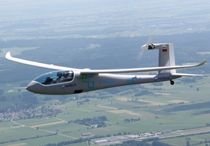
The past few weeks have seen two high marks set for electric flight — one in distance and one in speed — but not at the same time. The eGenius is a two-seat motor glider with a wingspan just over 55 feet adapted for electric flight bya team from the University of Stuttgart. It was modified with a forward-facing, tail-mounted 80-hp electric motor and last month flew with full seats on a back-and-forth course between two cities near Mindleheim, Germany, for just over two hours. That flight averaged more than 100 mph. Meanwhile a tiny twin-engine Cri-Cri managed a speed of 175 mph flying at the Paris Air Show, but managed that speed just long enough to record the mark.
The Cri-Cri runs two 35-horsepower electric motors drawing current from 1.5 kWh batteries that can sustain it for 25 minutes at 65 mph and far fewer minutes at 175 mph. For comparison, the eGenius landed after its two hours with some power remaining in the aircraft’s 56-kilowatt-hour battery pack, according to its creators. Specific figures defining its power reserves were not revealed, perhaps because the team aims to enter the aircraft in NASA/CAFE’s Green Flight Challenge to collect a prize of $1.3 million. That event will run Sept. 25 through Oct. 3 at Charles M. Schulz Sonoma County Airport in Santa Rosa, Calif. The winning aircraft will fly 200 miles in less than two hours using the energy equivalent of less than 1 gallon of gasoline per occupant. And eGenius appears to fit that bill.


































